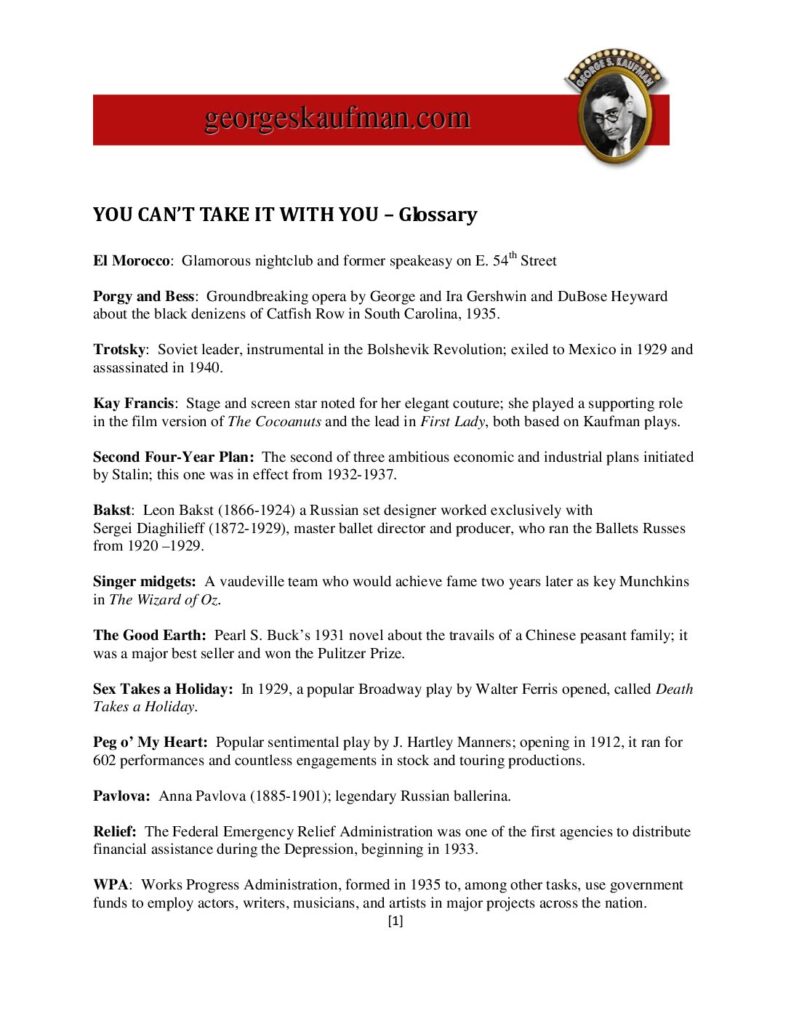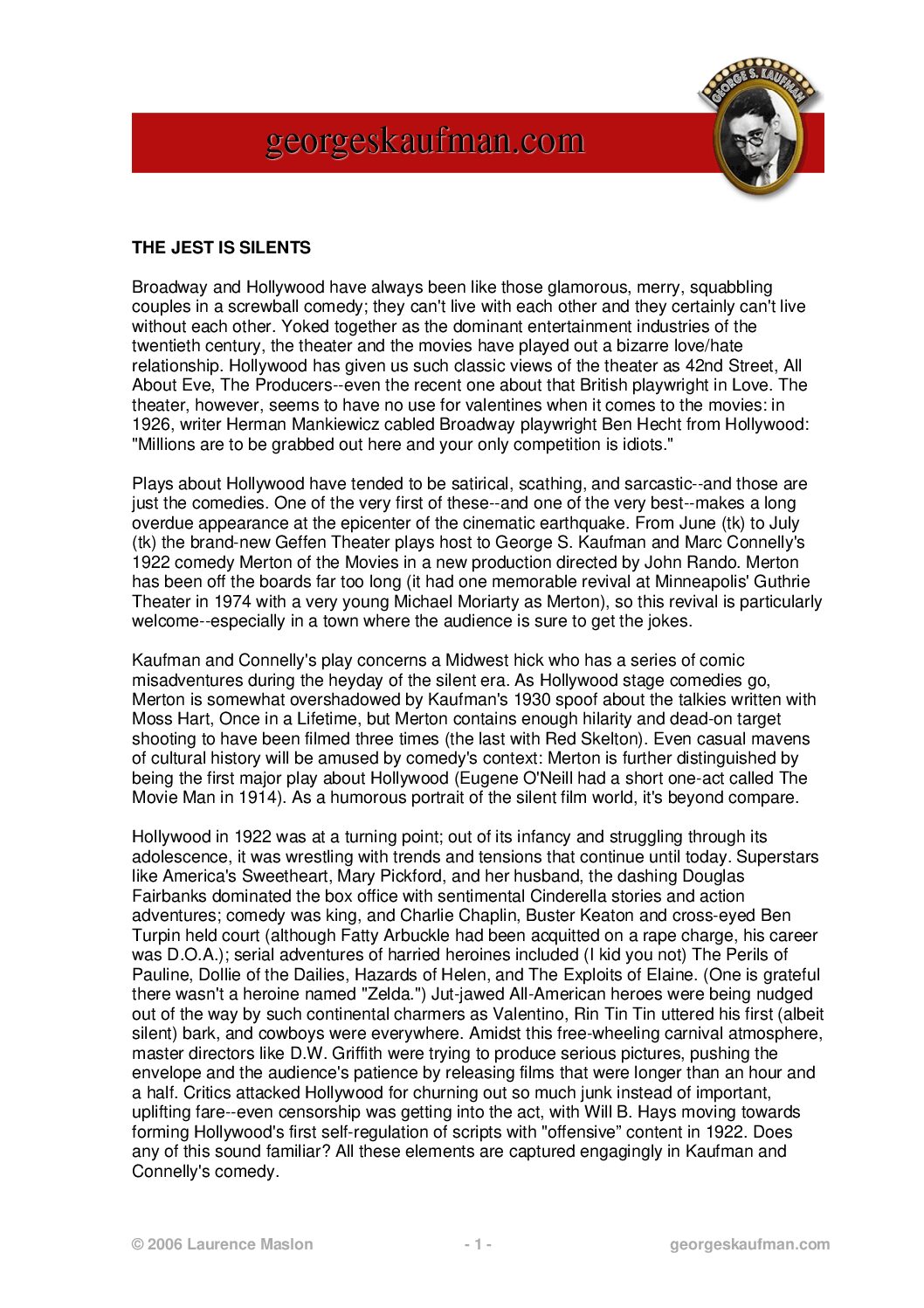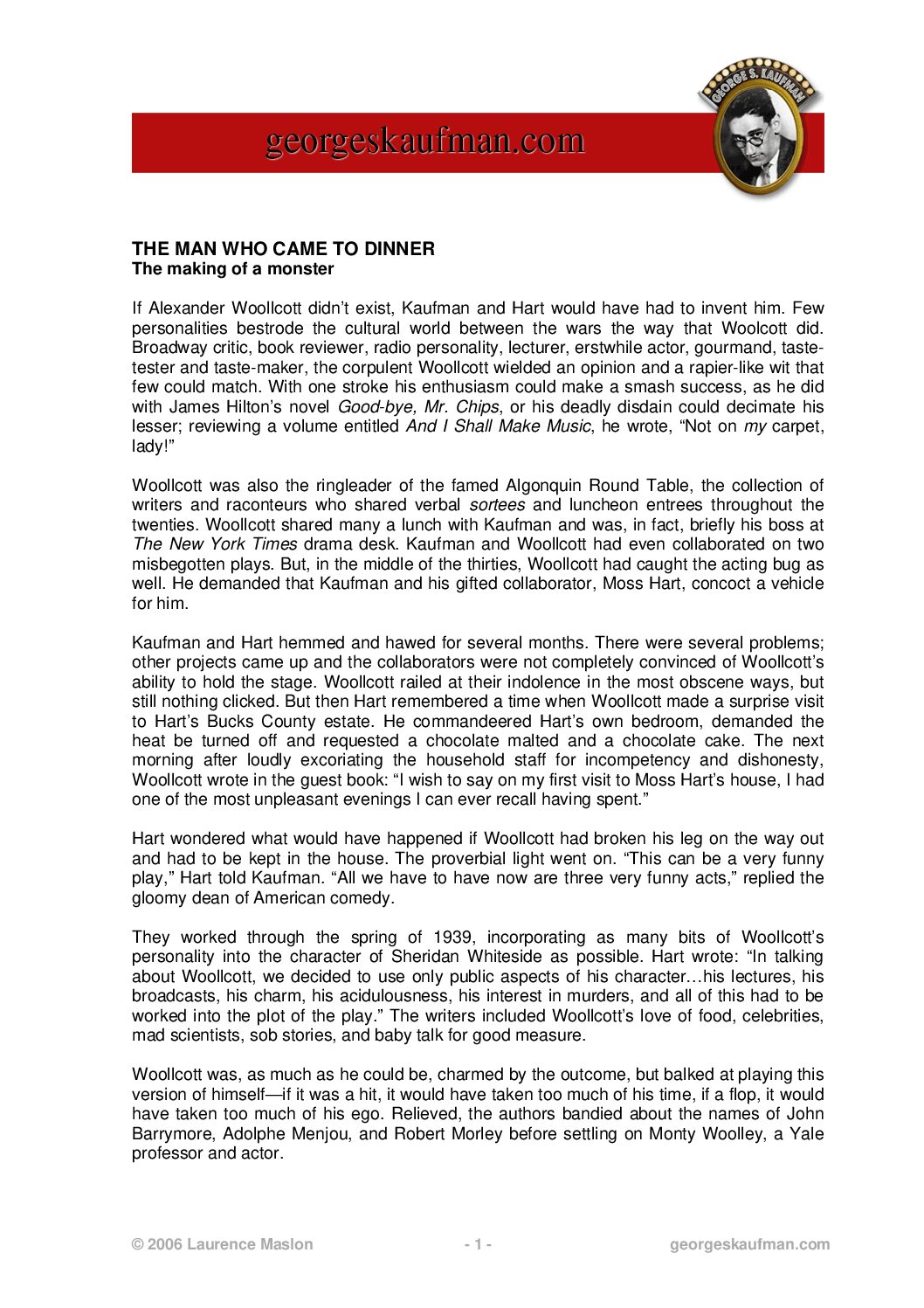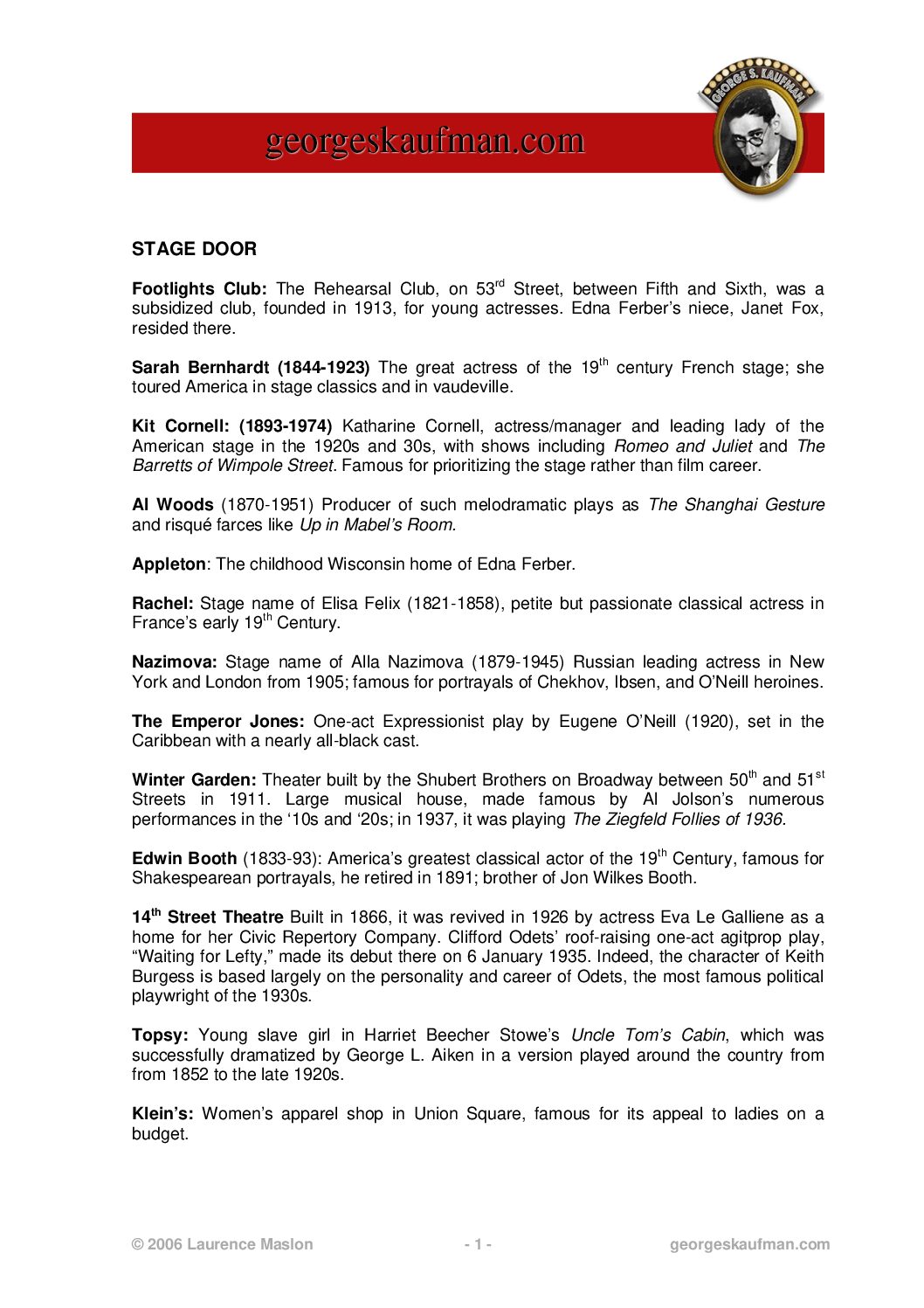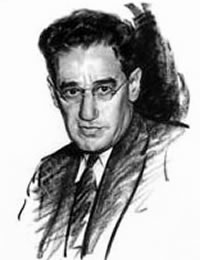The Jest Is Silents
The Jest Is Silents
From the George S. Kaufman Archive
The Jest Is Silents
By Laurence Maslon
Broadway and Hollywood have always been like those glamorous, merry, squabbling couples in a screwball comedy; they can’t live with each other and they certainly can’t live without each other. Yoked together as the dominant entertainment industries of the twentieth century, the theater and the movies have played out a bizarre love/hate relationship. Hollywood has given us such classic views of the theater as 42nd Street, All About Eve, The Producers–even the recent one about that British playwright in Love. The theater, however, seems to have no use for valentines when it comes to the movies: in 1926, writer Herman Mankiewicz cabled Broadway playwright Ben Hecht from Hollywood: “Millions are to be grabbed out here and your only competition is idiots.”
Plays about Hollywood have tended to be satirical, scathing, and sarcastic–and those are just the comedies. One of the very first of these–and one of the very best–makes a long overdue appearance at the epicenter of the cinematic earthquake. From June (tk) to July (tk) the brand-new Geffen Theater plays host to George S. Kaufman and Marc Connelly’s 1922 comedy Merton of the Movies in a new production directed by John Rando. Merton has been off the boards far too long (it had one memorable revival at Minneapolis’ Guthrie Theater in 1974 with a very young Michael Moriarty as Merton), so this revival is particularly welcome–especially in a town where the audience is sure to get the jokes.
Kaufman and Connelly’s play concerns a Midwest hick who has a series of comic misadventures during the heyday of the silent era. As Hollywood stage comedies go, Merton is somewhat overshadowed by Kaufman’s 1930 spoof about the talkies written with Moss Hart, Once in a Lifetime, but Merton contains enough hilarity and dead-on target shooting to have been filmed three times (the last with Red Skelton). Even casual mavens of cultural history will be amused by comedy’s context: Merton is further distinguished by being the first major play about Hollywood (Eugene O’Neill had a short one-act called The Movie Man in 1914). As a humorous portrait of the silent film world, it’s beyond compare.
Hollywood in 1922 was at a turning point; out of its infancy and struggling through its adolescence, it was wrestling with trends and tensions that continue until today. Superstars like America’s Sweetheart, Mary Pickford, and her husband, the dashing Douglas Fairbanks dominated the box office with sentimental Cinderella stories and action adventures; comedy was king, and Charlie Chaplin, Buster Keaton and cross-eyed Ben Turpin held court (although Fatty Arbuckle had been acquitted on a rape charge, his career was D.O.A.); serial adventures of harried heroines included (I kid you not) The Perils of Pauline, Dollie of the Dailies, Hazards of Helen, and The Exploits of Elaine. (One is grateful there wasn’t a heroine named “Zelda.”) Jut-jawed All-American heroes were being nudged out of the way by such continental charmers as Valentino, Rin Tin Tin uttered his first (albeit silent) bark, and cowboys were everywhere. Amidst this free-wheeling carnival atmosphere, master directors like D.W. Griffith were trying to produce serious pictures, pushing the envelope and the audience’s patience by releasing films that were longer than an hour and a half. Critics attacked Hollywood for churning out so much junk instead of important, uplifting fare–even censorship was getting into the act, with Will B. Hays moving towards forming Hollywood’s first self-regulation of scripts with “offensive” content in 1922. Does any of this sound familiar? All these elements are captured engagingly in Kaufman and Connelly’s comedy.
Ironically, neither Kaufman nor Connelly had been to Hollywood when they wrote the play, and neither had the man on whose serialized novel they had based the play. Harry Leon Wilson was a jack-of-all-trades writer whose installments of “Merton of the Movies” in the Saturday Evening Post were so amusing to Kaufman and Connelly that they secured the stage rights to the material before the two-month-long serial had even come to its conclusion. “Merton” served Kaufman and Connelly’s modus operandi perfectly. They had been writing together since 1921; starting as lunch partners at New York’s famed Algonquin Round Table, they became hit playwrights with Dulcy, which made a star out of a very young Lynn Fontanne. In the seven plays that followed between then and 1924, when Kaufman and Connelly amicably went their several ways, the two Pennsylvania natives came up with a successful formula: jolly comedies about an amiable dope whose good intentions triumph over avariciousness or snobbery. The boob is usually aided by a wisecracking woman with her head screwed on straight. These fables were perfect tonics for the 1920s; the drive to get ahead in society was so relentless that the American Dream needed a little ribbing. One could call the typical Kaufman-Connelly hero “The Guileless Gatsby.”
Merton Gill, the eponymous hero, certainly qualifies as guileless. Smitten by the flickers, he spends his days saving his small salary at the Simsbury General Store and his evenings dreaming of becoming the next cowboy star. This young man goes west, haunting a Hollywood casting office, bustling with the amusing and eccentric characters that were Kaufman’s stock-in-trade, and is befriended by “Flips,” the greatest stuntwoman in Los Angeles. (Merton is shocked to discover that starlet Beulah Baxter doesn’t perform her own stunts in “Hazards of Hortense”.) Merton’s first appearance on the set as an extra ends in disaster, until “Flips” notices his astounding resemblance to matinee idol Harold Parmalee and gets her pal, Jeff Baird, the comedy king of Buckeye Studios (clearly modelled on Mack Sennett) to star Merton in a series of spoofs on Parmalee’s persona. Only thing is, Merton, with his unswerving loyalty to “serious screen pictures,” can’t be let in on the joke. To say that, ultimately, the worst actor in silent films becomes its greatest sensation speaks more to the timeless mediocrity of Hollywood than anything else.
The original 1922 production of Merton ran for 398 performances, at a time when half that number of performances could make a hit. It was reported that Valentino himself was in the opening night audience, and having a good time. Broadway audiences had a good time, too, perhaps jollying themselves along with the thought that silent pictures couldn’t be much of a threat to the Theater; after all, movies were so darned silly–and they didn’t even have dialogue. Five years later, around the corner from the Cort Theater where Merton opened, Warner Brothers would debut its Vitaphone release at the Warners’ Theater: it was called The Jazz Singer. This, of course, would make it a lot harder to laugh at Hollywood from a plush red velvet theater seat on Broadway. But, this spring, audiences can sit in the Geffen Theater in Los Angeles, where it all began and laugh at when it all began.
Laurence Maslon is an associate arts professor at NYU’s Tisch School of the Arts. He is the editor of Kaufman & Co. for the Library of America.
Copyright 2006.
By Laurence Maslon
Broadway and Hollywood have always been like those glamorous, merry, squabbling couples in a screwball comedy; they can’t live with each other and they certainly can’t live without each other. Yoked together as the dominant entertainment industries of the twentieth century, the theater and the movies have played out a bizarre love/hate relationship. Hollywood has given us such classic views of the theater as 42nd Street, All About Eve, The Producers–even the recent one about that British playwright in Love. The theater, however, seems to have no use for valentines when it comes to the movies: in 1926, writer Herman Mankiewicz cabled Broadway playwright Ben Hecht from Hollywood: “Millions are to be grabbed out here and your only competition is idiots.”
Plays about Hollywood have tended to be satirical, scathing, and sarcastic–and those are just the comedies. One of the very first of these–and one of the very best–makes a long overdue appearance at the epicenter of the cinematic earthquake. From June (tk) to July (tk) the brand-new Geffen Theater plays host to George S. Kaufman and Marc Connelly’s 1922 comedy Merton of the Movies in a new production directed by John Rando. Merton has been off the boards far too long (it had one memorable revival at Minneapolis’ Guthrie Theater in 1974 with a very young Michael Moriarty as Merton), so this revival is particularly welcome–especially in a town where the audience is sure to get the jokes.
Kaufman and Connelly’s play concerns a Midwest hick who has a series of comic misadventures during the heyday of the silent era. As Hollywood stage comedies go, Merton is somewhat overshadowed by Kaufman’s 1930 spoof about the talkies written with Moss Hart, Once in a Lifetime, but Merton contains enough hilarity and dead-on target shooting to have been filmed three times (the last with Red Skelton). Even casual mavens of cultural history will be amused by comedy’s context: Merton is further distinguished by being the first major play about Hollywood (Eugene O’Neill had a short one-act called The Movie Man in 1914). As a humorous portrait of the silent film world, it’s beyond compare.
Hollywood in 1922 was at a turning point; out of its infancy and struggling through its adolescence, it was wrestling with trends and tensions that continue until today. Superstars like America’s Sweetheart, Mary Pickford, and her husband, the dashing Douglas Fairbanks dominated the box office with sentimental Cinderella stories and action adventures; comedy was king, and Charlie Chaplin, Buster Keaton and cross-eyed Ben Turpin held court (although Fatty Arbuckle had been acquitted on a rape charge, his career was D.O.A.); serial adventures of harried heroines included (I kid you not) The Perils of Pauline, Dollie of the Dailies, Hazards of Helen, and The Exploits of Elaine. (One is grateful there wasn’t a heroine named “Zelda.”) Jut-jawed All-American heroes were being nudged out of the way by such continental charmers as Valentino, Rin Tin Tin uttered his first (albeit silent) bark, and cowboys were everywhere. Amidst this free-wheeling carnival atmosphere, master directors like D.W. Griffith were trying to produce serious pictures, pushing the envelope and the audience’s patience by releasing films that were longer than an hour and a half. Critics attacked Hollywood for churning out so much junk instead of important, uplifting fare–even censorship was getting into the act, with Will B. Hays moving towards forming Hollywood’s first self-regulation of scripts with “offensive” content in 1922. Does any of this sound familiar? All these elements are captured engagingly in Kaufman and Connelly’s comedy.
Ironically, neither Kaufman nor Connelly had been to Hollywood when they wrote the play, and neither had the man on whose serialized novel they had based the play. Harry Leon Wilson was a jack-of-all-trades writer whose installments of “Merton of the Movies” in the Saturday Evening Post were so amusing to Kaufman and Connelly that they secured the stage rights to the material before the two-month-long serial had even come to its conclusion. “Merton” served Kaufman and Connelly’s modus operandi perfectly. They had been writing together since 1921; starting as lunch partners at New York’s famed Algonquin Round Table, they became hit playwrights with Dulcy, which made a star out of a very young Lynn Fontanne. In the seven plays that followed between then and 1924, when Kaufman and Connelly amicably went their several ways, the two Pennsylvania natives came up with a successful formula: jolly comedies about an amiable dope whose good intentions triumph over avariciousness or snobbery. The boob is usually aided by a wisecracking woman with her head screwed on straight. These fables were perfect tonics for the 1920s; the drive to get ahead in society was so relentless that the American Dream needed a little ribbing. One could call the typical Kaufman-Connelly hero “The Guileless Gatsby.”
Merton Gill, the eponymous hero, certainly qualifies as guileless. Smitten by the flickers, he spends his days saving his small salary at the Simsbury General Store and his evenings dreaming of becoming the next cowboy star. This young man goes west, haunting a Hollywood casting office, bustling with the amusing and eccentric characters that were Kaufman’s stock-in-trade, and is befriended by “Flips,” the greatest stuntwoman in Los Angeles. (Merton is shocked to discover that starlet Beulah Baxter doesn’t perform her own stunts in “Hazards of Hortense”.) Merton’s first appearance on the set as an extra ends in disaster, until “Flips” notices his astounding resemblance to matinee idol Harold Parmalee and gets her pal, Jeff Baird, the comedy king of Buckeye Studios (clearly modelled on Mack Sennett) to star Merton in a series of spoofs on Parmalee’s persona. Only thing is, Merton, with his unswerving loyalty to “serious screen pictures,” can’t be let in on the joke. To say that, ultimately, the worst actor in silent films becomes its greatest sensation speaks more to the timeless mediocrity of Hollywood than anything else.
The original 1922 production of Merton ran for 398 performances, at a time when half that number of performances could make a hit. It was reported that Valentino himself was in the opening night audience, and having a good time. Broadway audiences had a good time, too, perhaps jollying themselves along with the thought that silent pictures couldn’t be much of a threat to the Theater; after all, movies were so darned silly–and they didn’t even have dialogue. Five years later, around the corner from the Cort Theater where Merton opened, Warner Brothers would debut its Vitaphone release at the Warners’ Theater: it was called The Jazz Singer. This, of course, would make it a lot harder to laugh at Hollywood from a plush red velvet theater seat on Broadway. But, this spring, audiences can sit in the Geffen Theater in Los Angeles, where it all began and laugh at when it all began.
Laurence Maslon is an associate arts professor at NYU’s Tisch School of the Arts. He is the editor of Kaufman & Co. for the Library of America.
Copyright 2006.
More from the
George S. Kaufman Archive
Contact Us Today
Interested in bringing George S. Kaufman’s timeless plays to your stage?
Please refer to the contact information for each specific play on the various collection pages for direct amateur and professional licensing information.
Plays are represented by Concord Theatricals, Broadway Dramatic Licensing, and Music Theatre International respectively
If you are interested in first-class performance or film/television rights:
In the US, George S. Kaufman’s plays are represented by:
CPK Artists, LLC
In the UK, George S. Kaufman’s plays are represented by:
Alan Brodie Representation
For more information about George S. Kaufman or this website, contact:
Laurence Maslon
Literary Trustee, George S. Kaufman Estate

